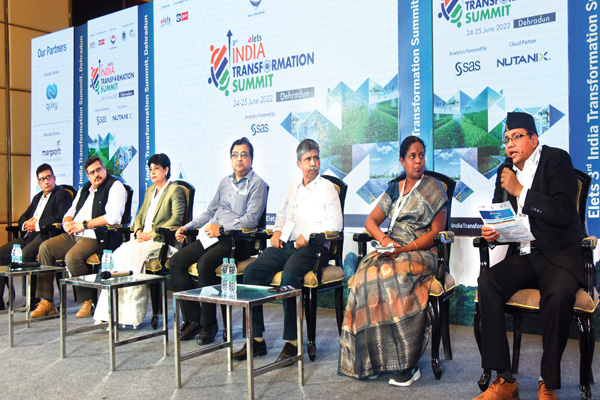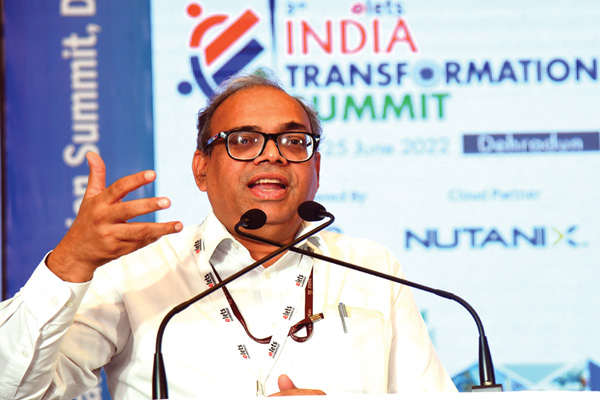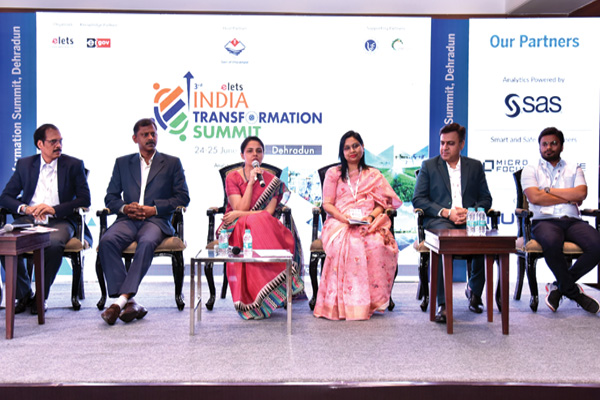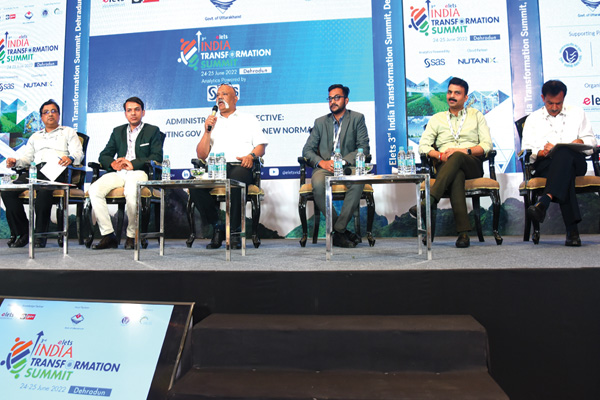
Any government or its success depends fairly on how it manages its finances, which basically involves revenue generation and expenditure. Highlighting this, Dheeraj Rastogi, Senior Vice President, GSTN, Government of India; M.Y. Ittoo, Director General (Budget), Department of Finance, Government of J&K; Sandeep Malvi, Additional Municipal Commissioner, Thane Municipal Corporation & Chief Executive Officer, Thane Smart City Ltd; and Saptrishi Dutta, Senior Consultant Analytics, SAS India, spoke at the Elets India Transformation Summit

Dheeraj Rastogi, Senior Vice President, GSTN, Government of India
Dheeraj Rastogi, Senior Vice President, GSTN, Government of India spoke about the motive of the Goods & Services Tax Network (GSTN) portal. “The main motive of having GSTN was primarily the accounting of the revenue. Whatever revenue is filed, you have to receive the declarations and taxes and distribute it between the states,” he said.
Rastogi then explained the benefits of having such platforms. He said, “The benefit was that all the declarations were in one place. One could easily find out the tax, which was going into crevices of the department’s existence in the past, was now available and visible.”

“So, something was produced and excise duty was paid. Then, the same thing was sold and VAT was paid, and thereafter the same goods were used for providing rendering services. If you match all three declarations, you find that revenue is bound to increase. That was the philosophy behind the GST also,” he added.
Rastogi also deliberated on the kind of efforts the GSTN portal has made in tackling the issue of tax collection, by using data analytics. He highlighted that the analytics they had put in place played a big part in identifying fake bill issuers. “They were issuing fake bills only for the purpose of income tax, to inflate the expenses, so that they won’t have to pay taxes on the entire income,” he said.

“With the analytics we put in place, we were able to identify the people who are the fake bill issuers and who are pushing credit into the system without paying any tax. So now, if you stop that leakage, the taxes automatically increase and that is visible in the GST collections over the years,” he added.
“The first year, i.e. 2017, we started with about Rs 90,000 crore in a month. Now, it is consistently touching Rs 1,40,000 crore every month,” Rastogi concluded.

M.Y. Ittoo, Director General (Budget), Department of Finance, Government of J&K
Highlighting the problem of optimising revenue which the Government of J&K is facing, M.Y. Ittoo, Director General (Budget), Department of Finance, Government of J&K, said, “We are having more revenue expenditure than capital expenditure.”
“To find the resource, to meet the expenditure, the need, we have funding from the Government of India in respect of sharing taxes, but since we are a Union Territory now, we are getting a unified grant,” he added.
With the collaboration of NIC, the department introduced some IT- enabled systems. “We have introduced BEAMS (budget estimation allocation monitoring system). We have every record of revenue the departments are collecting, they put it on BEAMS, so that we know what collection is with us and we can distribute that resource.”
The department had introduced another IT-enabled system and named it as empowerment and later changed the name to the ‘Janbhagidari Empowerment’.
“What we have learned so far is that if we have no resources, let us optimise in both ways – the revenue side as well as the expenditure side,” Ittoo said.
Highlighting the power of technology, Ittoo explained how the department collected more revenue with the use of technology. “In South Asia, we have one of the biggest tulip gardens, which only stays open for just 20 days and this time, we had a walk of almost 4 lakh tourists, generating more than Rs 30 lakh revenue,” he said.
“Last year, we were collecting cash and from this year onwards, we have started using UPI or QR code or payments,” Ittoo added.
“Technology has really helped in revenue collection,” he concluded.

Sandeep Malvi, Additional Municipal Commissioner, Thane Municipal Corporation & Chief Executive Officer, Thane Smart City Ltd
Sandeep Malvi, Additional Municipal Commissioner, Thane Municipal Corporation & Chief Executive Officer, Thane Smart City Ltd spoke about the benefits of technology and its role in increasing revenue.
“First, we identify the basic revenue resources for municipalities, like property tax, water tax, advertisement tax, town planning, etc. After identifying these revenue resources, the challenge of how to increase revenue arises,” he said.
Malvi also talked about the Digithane app. “We started India’s first digital platform ‘Digithane’, on the lines of Israel technology. Now, almost 300,000 people are registered with this app and more than 20,000 people use this app every day. It is a one-stop-shop for all the municipality and merchandise services,” he said.
“Through Digithane, we provide merchant portals to connect with the establishments, facility of paying online, and also 5 per cent rebate to those who pay online, through this app,” he added.
“Most of the people have started using this app to pay their taxes. We collected more than Rs 31 crore last year from this app, out of 600 crore, so that is a big benefit of technology,” he further said.
Malvi talked about another app – Smart Water Metre Reading – through which one can know how much water he has used and how much he’s paying for it. “67,000 smart water metres have been installed in slums, commercial complexes, and residential apartments,” he said.

Saptrishi Dutta, Senior Consultant Analytics, SAS India
Talking about revenue maximisation and digitisation, Saptrishi Dutta, Senior Consultant Analytics, SAS India, said, “With this advancement of digitisation, you have a humongous amount of data. That is an area of opportunity for SAS, being the biggest analytics company in the world.”
“We are trying to cater – starting from planning to revenue optimisation and finally doing a complete investigation. Have a proper framework to investigate the problems and it should not be just in pen and paper. The highest authority has to say that this case needs to be closed in this way, so that you have a complete digital track record,” Dutta explained.
“In stamps and registration, the kind of automation and analytics we have shown is simply fabulous,” he concluded.
Be a part of Elets Collaborative Initiatives. Join Us for Upcoming Events and explore business opportunities. Like us on Facebook , connect with us on LinkedIn and follow us on Twitter, Instagram.











